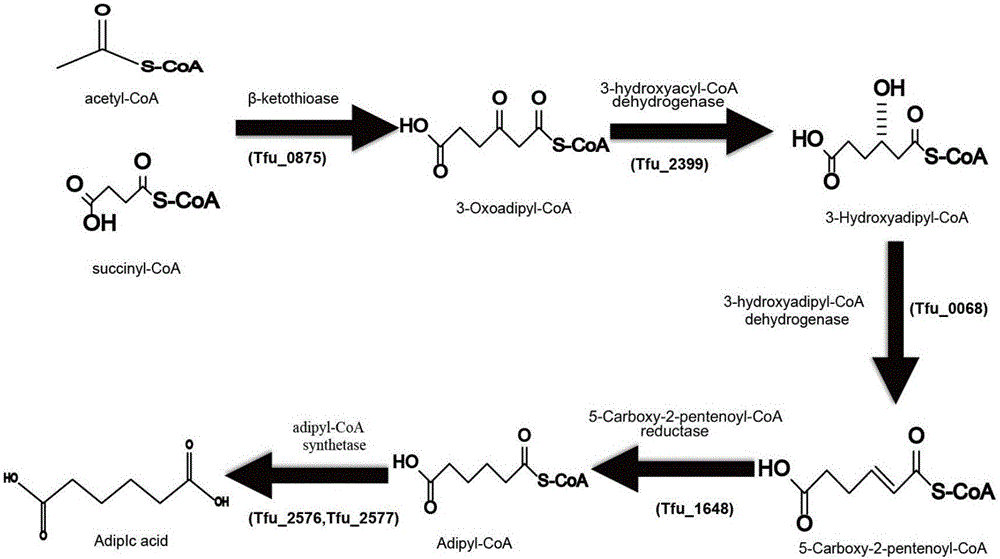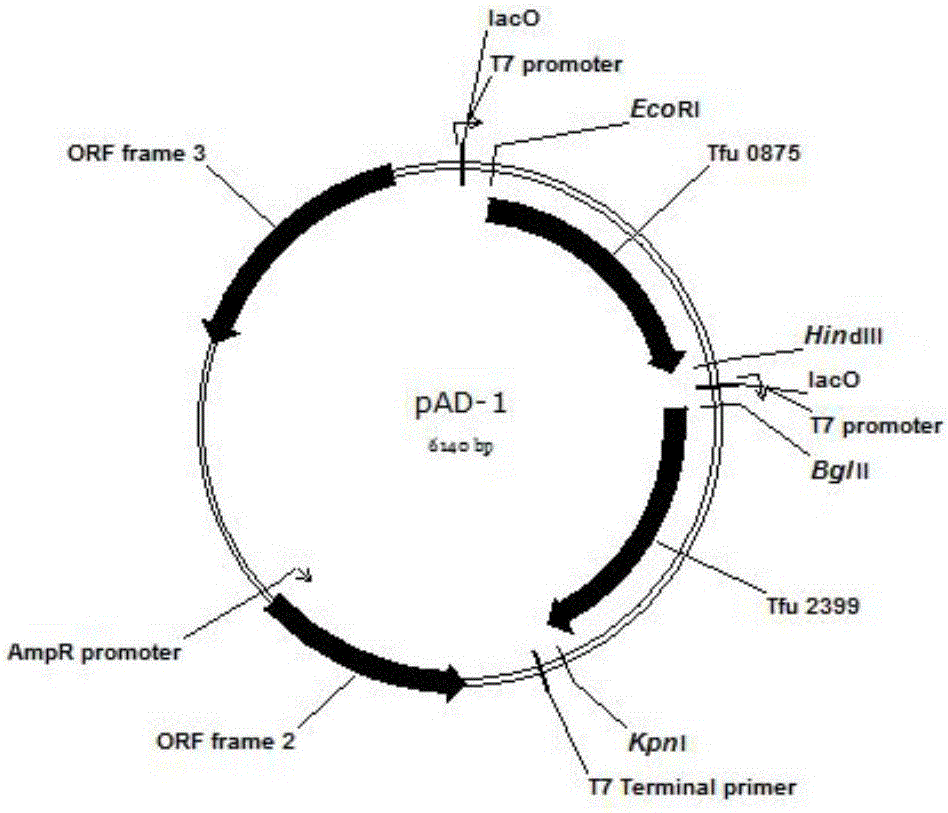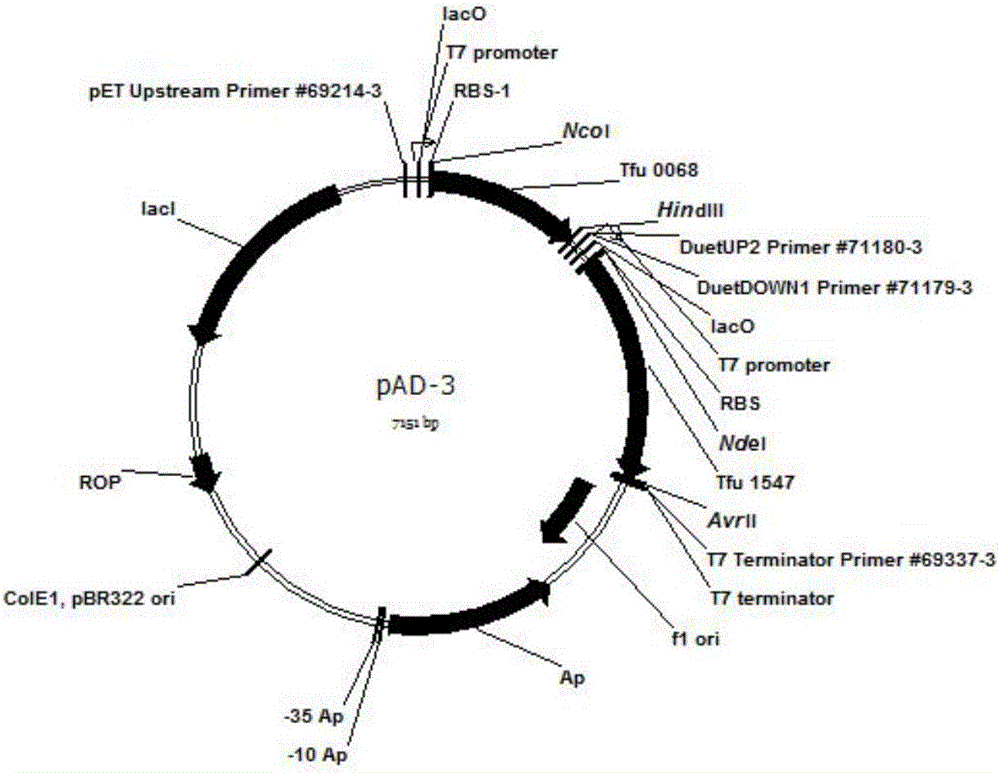Method for enhancing adipic acid yield in Escherichia coli
A technology of Escherichia coli and recombinant Escherichia coli, which is applied in the field of bioengineering, can solve the problems of long routes, low adipic acid yield, etc., and achieves the effects of reducing the degree of pollution and convenient and simple recovery.
- Summary
- Abstract
- Description
- Claims
- Application Information
AI Technical Summary
Problems solved by technology
Method used
Image
Examples
Embodiment 1
[0036] Example 1: Construction of recombinant plasmid pAD-1 and acquisition of recombinant Escherichia coli.
[0037]The sequences of Tfu_0875, Tfu_2399, Tfu_0068, Tfu_1648, Tfu_2576, Tfu_2577 have been published in NCBI before the filing date.
[0038] Plasmid pRSFDuet-1 was double-digested with EcoR I and Hind III, the target gene fragment (3798bp) was recovered by cutting the gel, and the plasmid pUC57-Tfu_0875 was digested with the same enzyme, the target gene fragment Tfu_0875 was recovered by cutting the gel, and then the two target fragments were used T 4 DNA ligase ligation, transformation of JM109, positive transformants were picked by colony PCR, and the extracted plasmid was digested for verification. The verified plasmid was named pRSF-Tfu_0875. Digest the plasmid pRSF-Tfu_0875 with Bgl II and Kpn I, cut the gel to recover the 4936bp target gene fragment, digest the plasmid pUC57-Tfu_2399 with the same enzyme, cut the gel to recover the target gene fragment, and ...
Embodiment 2
[0041] Example 2: Optimization of preliminary shake flask fermentation conditions for recombinant Escherichia coli Mad1.
[0042] Fermentation medium:
[0043] SOB medium, the composition is 2% tryptone + 0.5% yeast powder + 0.05% NaCl + 2.5mM KCl + 10mM MgCl 2 +8g / L glucose+50μg / ml kanamycin sulfate+50μg / ml ampicillin+50μg / ml streptomycin.
[0044] M9 medium: M9 salt solution + 8g / L glucose + 2mM MgSO 4 +0.1mM CaCl 2 + 50 μg / ml kanamycin sulfate + 50 μg / ml ampicillin + 50 μg / ml streptomycin.
[0045] LB medium: 1% tryptone + 0.5% yeast powder + 1% NaCl + 8g / L glucose + 50μg / ml kanamycin sulfate + 50μg / ml ampicillin + 50μg / ml streptomycin.
[0046] MOPS medium: 40mM MOPS+0.3%NH 4 Cl+0.1%K 2 HPO 4 +2mM MgSO 4 +0.1mM CaCl 2 +50mM NaCl+100mM Bis-Tris+134μM EDTA+31μM FeCl 3 +6.2 μM ZnCl 3 +0.76 μM CuCl 2 +0.42 μM H 3 BO 3 +0.081 μM MnCl 2 + 50 μg / ml kanamycin sulfate + 50 μg / ml ampicillin + 50 μg / ml streptomycin.
Embodiment 3
[0051] Embodiment 3: Mad1, Mad2 shake flask fermentation and result analysis.
[0052] Fermentation medium: SOB medium, the composition is 2% tryptone + 0.5% yeast powder + 0.05% NaCl + 2.5mMKCl + 10mM MgCl 2 +8g / L glucose+50μg / ml kanamycin sulfate+50μg / ml ampicillin+50μg / ml streptomycin.
[0053] Seed solution preparation: Streak the bacterial species preserved in glycerol on the plate, pick a single colony and inoculate it into a 250ml Erlenmeyer flask filled with 50ml of LB liquid medium, shake the flask at 37°C and 250r / min overnight.
[0054] Fermentation conditions: 2% inoculum size, inoculated in shake flask fermentation medium SOB to make initial OD 600 0.1. Cultivate to OD at 37℃, 250r / min 600 When it is about 0.6-0.8, add the corresponding inducer to induce the expression of 1mM IPTG to induce Mad1 and Mad2, and change to 30°C, 250rpm / min for culture.
[0055] Result analysis: take a sample every 4 hours during the fermentation process, centrifuge at 10,000r / min f...
PUM
 Login to View More
Login to View More Abstract
Description
Claims
Application Information
 Login to View More
Login to View More - R&D
- Intellectual Property
- Life Sciences
- Materials
- Tech Scout
- Unparalleled Data Quality
- Higher Quality Content
- 60% Fewer Hallucinations
Browse by: Latest US Patents, China's latest patents, Technical Efficacy Thesaurus, Application Domain, Technology Topic, Popular Technical Reports.
© 2025 PatSnap. All rights reserved.Legal|Privacy policy|Modern Slavery Act Transparency Statement|Sitemap|About US| Contact US: help@patsnap.com



